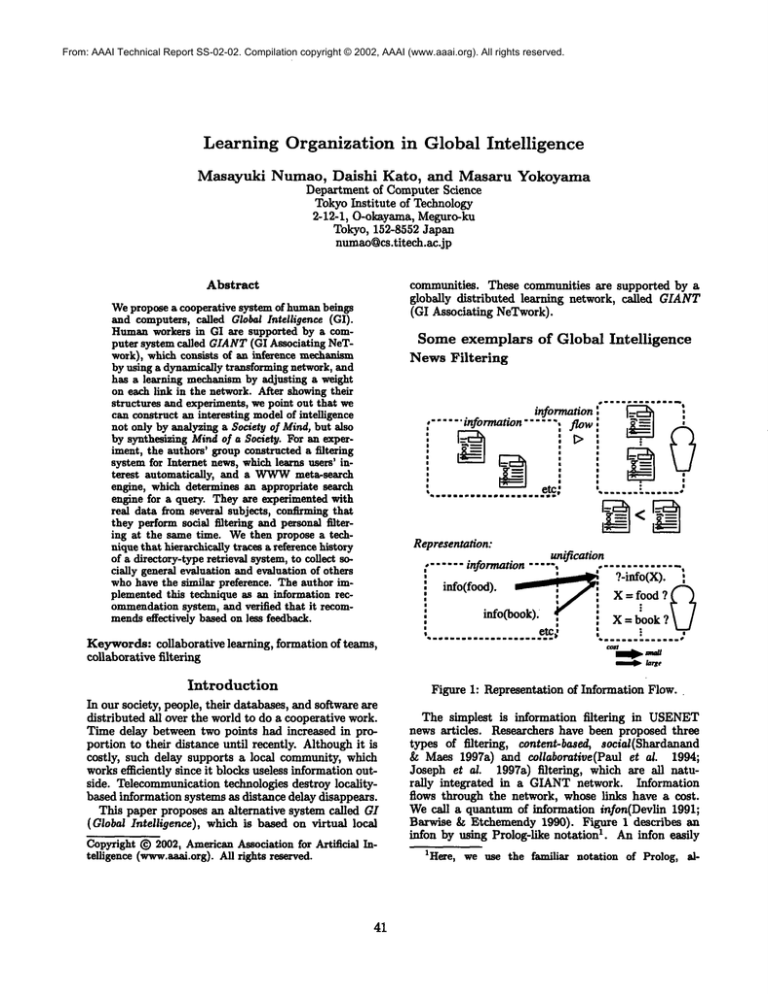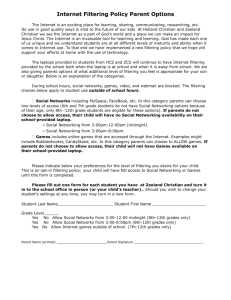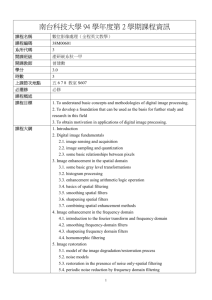
From: AAAI Technical Report SS-02-02. Compilation copyright © 2002, AAAI (www.aaai.org). All rights reserved.
Learning
Organization
in Global
Masayuki Numao, Daishi
Kato,
Intelligence
and Masaru Yokoyama
Department of Computer Science
TokyoInstitute of Technology
2-12-1, O-ol~yama, Meguro-ku
Tokyo, 152-8552 Japan
numao~}cs.titech.ac.jp
communities. These communities are supported by a
globally distributed learning network, called GIANT
(GI Associating NeTwork).
Abstract
Wepropose a cooperative system of humanbeings
and computers,called GlobalIntelligence (GI).
Humanworkers in GI are supported by a computer system called GIANT(GI Associating NeTwork), whichconsists of an inference mecb~nlgm
by using a dynamicallytransforming network, and
has a learning mechanismby adjusting a weight
on each link in the network. After showingtheir
structures and experiments, we point out that we
can construct an interesting modelof intelligence
not only by analyzinga Society of Mind, but also
by synthesizing Mindof a Society. For an experiment, the authors’ groupconstructed a filtering
systemfor Internet news, whichlearns users’ interest automatically, and a WWW
meta-search
engine, which determines an appropriate search
engine for a query. They are experimentedwith
real data from several subjects, coBflrmi-g that
they performsocial filtering and personalfiltering at the same time. Wethen propose a techniquethat hierarchicallytraces a referencehistory
of a directory-typeretrieval system,to collect socially general evaluation and evaluation of others
whohave the similar preference. The author implementedthis technique as an information recommendation
system, and verified that it recommendseffectively basedon less feedback.
Some exemplars of Global Intelligence
News Filtering
¯ " ..... information
N
information:
.......flow :
etc’
:
.
~
~
.
. ..... " ......
Representation:
unification
¯ " ..... information ..... ,
info(food).
Keywords:collaborative learning, formation of teams,
collaborative filtering
Introduction
info(book). ,,
etc~
?-info(X).
’ Xff..ood?~
, X= l~.o
ok?
¯
’I
/arSe
Figure
I: Representation
of Information Flow..
In our society, people, their databases, and software are
distributed all over the world to do a cooperative work.
Time delay between two points had increased in proportion to their distance until recently. Althoughit is
costly, such delay supports a local community, which
worksefficiently since it blocks useless information outside. Telecommunicationtechnologies destroy localitybased information systems as distance delay disappears.
This paper proposes an alternative system called GI
(Global Intelligence), which is based on virtual local
Copyright(~) 2002, AmericanAssociationfor Artificial Intelligence (www.~-aal.org).
All rights reserved.
41
The simplest is information filtering in USENET
news articles. Researchers have been proposed three
types of filtering, content-based, social(Shardanand
& Maes 1997a) and collaborative(Paul et al. 1994;
Joseph et al. 1997a) filtering, which are all naturally integrated in a GIANTnetwork. Information
flows through the network, whose links have a cost.
Wecall a quantum of information i,/on(Devlin 1991;
Bsxwise & Etchemendy 1990). Figure 1 describes an
infon by using Prolog-like notation I. An infon easily
IHere, we use the familiar notation of Prolog, al-
movesthrough a link if the cost is small. It hardly
movesif the cost is large. This determines priority of
information and the result of filtering. The cost is calculated based on past impressions the users have. In
our everyday life, we usually have a time of nonsense
conversations, such as greetings. Wecan say that they
determine the cost of links in the frameworkof GI.
Learninga person’s
taste
Learning prediction
-
Learninga social
evaluation
~aery
7-nicenews(tom
,Id).
nicenews(Ri/~r,Id)
news(Grp,Atrl,Atr2,Atr3,Atr4,1d),
g_.~(Grp,Atrl), g_.ap(Grp,Alr2), ...,
r.~p(l~ader,Grp),
f_ap(/~fr 1,Atr2), a_.ap~
a_ap(Atrl,Atr3)e ¯.,
ooo
#tr(~q~ atr(A~2),
¯ ¯ ..
Evaluation in
g~p( g 1/~:-atr(A~.
¯ ¯ *.
__=
l_aP( chifies~ ,~-’atr(~r)
a community
Memberofacommunity
¯ ¯ ..
Attribute’s relation
Communi
O,
ttr(chinese ).~
ttr(noodle).
tr(curry
).¯ ¯ ¯
news(gI ,chinese,noodle,shop,any
,article 1 ).
Attributes
Article
Figure 3: Transfer Rules
I~aming
prediction
Figure 2: GIANTfor NewsFiltering.
Wedescribe a GIANTfor news filtering as shown
in Figure 2 (Yokoyama & Numao1997), where A are articles. 1 - 3 are keywordsor some features for
content-based evaluation. X- Z are readers. The nodes
gl - g3 represent a communityor a group of subjects
that evaluate articles. Whenit learns a person’s taste,
the taste is learned based on somearticles. It predicts
evaluation by the person of an unseen article. Whenit
learns a social evaluation, each evaluation of articles is
learned based on somesubjects. It predicts evaluation
by a new subject. Mixture of these two types enables
more precise prediction. A communityis dynamically
added during the learning process, i.e., the topology
of network is dynamically transformed. The network
is described in predicate logical formulas to describe
such transformation(Numao, Morita, & Karaki 1999).
Figure 3 shows transfer rules describing the network
shownin Figure 2.
If a user evaluates an article highly, the costs of links
along the path are decreased. If he/she evaluates an
article lowly, it is increased. This is a kind of relevance
feedback. In its learning process, X first tries to train a
though it is formally inaccurate to represent an infon.
Somenotations for formal analysis appear in (Barwise
Etchemendy1990). As an infon-based programminglanguage, Presit(Nakashima,Peters, & Schiitze 1991) is constructed on Prolog.
42
subnetwork through a communitygl, which represents
a taste of X. WhenY obtains information from gl,
if he/she likes it, the cost of link between gl and Y
decreases. This means that Y participates in the community gl. If he/she hates it, the cost increases, and
Y tries to train a subnetwork through a new community g2. As such, the users’ evaluations cultivate some
communities.
Eachuser evaluates an article in 7 grades: 7 for the
best and 1 for the worst. The system updates cost of
each link c~ by c~:
= + (8- E - C)c,/C
where E is the evaluation by user and C is the sum of
costs E~cl along the path. This update process is based
on an inference path, and related to learning based
on plausible explanations (DeJong & Oblinger 1993;
2.
Widmer1994)
Kephart, Hanson and Greenwald proposed to apply
dynamicpricing by soft, are agent to information illtering(Kephart, Hanson, & Greenwald2000). It can
interesting to analyze the above mechanismof information filtering from the view point of the global economy.
VV’Vq’Vv" Search Engines
The filtering methodis easily applied to a WWW
search
engine, although information is not filtered out but retrieved. Figure 4 describes search based on a hierarchical directory(Numao & Yokoyama1999). The interface
aIt might be analyzed based on reinforcement learning,
since the process is distributed over someagents, although
the authors havenot tried the analysis.
assumes that (s)he is interested in both in Skiing and
United States. By this, it recommendspages in more
categories.
Figure 4 shows a GIANT
network representing a hierarchy. The nodes gl, g~ and g3 represent a community
similar to Figure 2. Other than communities,it tries to
find some recommenderswhohave the same taste as its
user in the requested category or its upper categories.
pages
Meta-search
Soci~
[~1~
[~
~ ...i
.-~’f
Engines
recommenders
//.U.../"
Figure 4: Searching a WWW
page.
is almost the same as one of Yahooexcept that it has
a recommendationbutton, by which the user requests a
page recommendationin the current category.
The search is based on contents, communityand recommendation from another user. This method is implemented as a system called FRUIT.The authors employed the hierarchy used in Yahoo Japans. This version assumesthat the hierarchy represents the contents,
and does not analyze texts of each page.
Each person’s taste is dependent on a category of a
page. For example, who have the same taste in sport
mayhave different ones in music. The system compares
evaluation in a category requested by its user.
The user’s
history
is kept on all upper
hierarchy,
i.e.,
the
reference
to
/Recreation/Sports/Basketball
is recorded to
the category/Recreation,
/Recreation/Sports
and
/Recreat ion/Sport s/Basketball;
Therefore, the
upper category keeps more reference records.
Whenonly a few records are kept in a category, the
system refers its upper category to select a goodrecommender. If a user wants to see pages on basketball, a
recommenderwhohas a similar taste in sports is better
than one in computer.
Whena user requires pages in a category, page evaluation in its lower category is used to makemoreprecise
prediction.
The system traces
multiple
inheritance.
For example, Johnson, Bill appears both in
/Regional/Court’cries/Unit
ed States/Recrea’cion
and Sports/Spor~s/Sk$ing/Johnson,
B£11@ and
in /Recreazion/Sports/Skiing/Skiers/Johnson,
Bill. If a user refers to Johnson, Bill, the system
ahttp://www.yahoo.co.jp/,whichis the Japanese version
of http://www.yahoo.com/.
43
I
1- ,1
ooo
Figure 5: Meta-search engine.
A meta-search engine is a search engine for finding a good search engine(Howe & Dreilinger 1997;
Selberg &Etzionl 1997; Lawrence & Giles 1998). Each
search engine covers only a part of WWW
pages all over
the world. Meta-search integrates such expert search
engines into one big search engine. The problem is how
to select a search engine appropriate for user’s request.
Since a meta-search engine is a node in a network, it
is naturally integrated into GIANTas shown in Figure 5. As such, a meta-search engine is implementedas
a system called MetaRoamer(Kato & Numao1999).
Online
KARAOKE system
Online KARAOKE
systems are now a popular accompaniment system to enjoy singing in Japan. It has a
remote server with a huge database of MIDIfiles, which
covers almost all popular songs. Each KARAOKE
roomhas a terminal to downloada MIDIfile via a telephone line, and to sing with a microphone and speakers. The author discusses a delivering mechanismfor
music pieces based on preference of a user (Numao,
Kobayashi, & Sakaniwa 1997). GIANTprovides an intelligent networkfor it.
Document Reviewing
In news filtering and a search engine, information flows
one way only. In email and telephone, communications
are interactive. GIANT
is described in a predicate logical formula, which is programmableand interactively
and dynamically created as a situation changes.
Figure 6 describes a review process of funds, where
agents communicateeach other as error occurs in each
1.9
AUniversity
MEdme~nf
/~
~~
~.
weight
1.8
.~
1.7
Reviewers
i
i
~1.6
rill#
1.4
i
Figure 6: Global document system.
step, where somemessages are neglected based on priorities.
Software
i
i
i
i
~ i
1"30 200 400 600
800i 1
1200140016001800
Trainingexamples
Figure 8: The Result of Learning a Person’s Taste.
Figure 8 showsa learning process of a person’s taste.
The subjects evaluate an article in 7 grades. The system
learns evaluation of 1800 articles by 12 subjects. We
plot the difference between predicted evaluation of 10
unread articles and their evaluation by the subject every
time the systemlearns an article.
Development
User
. .....- ........
=.0[
..............
teme~
1.8[
,, ¯
|
¯
g
<
1.2
1.0
0.8
Figure 7: Software.
A bug in software is usually recognized as a differe~ce betweenits specification and its coding. This view
complicates a process of debugging. In reality, a bug
is caused by a different view of software between its
programmer and a user. GIANToffers a circulating
environment of software as shownin Figure 7.
Experiments
Up to now, we have conducted experiments in news filtering, WWW
search engine and meta-search engine.
Here we show some results on news filtering in Figure
2. The authors selected 150 articles in Japanese from
f~.food news group. They are evaluated in 7 grades by
12 subjects. A Japanese processing procedure(Mohri
Tanaka 1996) is employed to select some frequent and
important keywords to be used as an attribute. Features for other attributes are length, question/answer,
whether FYI(for your information) or not, etc.
44
06.
-’-u
1
t
i
i
i 1000
i 120014001600
200 400 l~1
~
800
Training
Examples
Figure 9: The Result of Learning a Social Evaluation.
Figure 9 showsa learning process of a social evaluation. The system determined a community in which a
user should participate based on evaluation of 30 articles. Then, the user trained the communitybased on
the rest articles. The result shows that the learning
process converges faster than that of the personal filteriug.
Organization of subjects appears as weights of links
between subjects X, Y, Z and communities gl, g2, g3.
The authors examine the weights and observe that GIANTorganized the 12 subjects into the following 5 communities:
. Excluding subject 6. Its memberslike Asia, question-
¯
¯
¯
¯
ingandshortarticles,
buthateanswering.
Including
3, 5, 10,andexcluding
2, 9, 12.Itsmemberslikedrinking,
fruit,
providing
FYIandanswering,buthatefish.
Including
4, 11,andexcluding
6, 9, 12.Itsmembers
likefish,
noodle
andJapan,
buthatedrinking.
Including
1, 2,11,andexcluding
6. Itsmembers
like
meat,discussion
of ingredients
andJapan,
buthate
restaurants.
Including
5, 7,8. Itsmembers
likefish,restaurant,
Asiaanda nearlocation,
buthatelongarticles.
lOO
go
8o
70
6o
i
iO
a
15o
i
200
|
260
i
300
i
38o
I
4400
i
480
Figure 11: A result in meta~search.
0.8
Acknowledgements
0.6
The experiments described in this paper are results
of a project conducted in the authors’ laboratory.
They would like to thank participants of the project:
Jun Kamino, Shigekazu Morita, Kensuke Maruya and
Satoshi Iino.
0.4
0.~
|
lOO
20
40
60
Figure I0: The click rate for WWW
search results.
In the case of WWW
pages, we need a search engine instead of an article filtering system. Weapply
the same mechanism as the above to search pages. A
WWWsearchenginecreates
andshowssomelinkpages
toitsuser,
whoclicks
onlysomeofthelinks.
Sinceit
ishardto obtain
evaluation
of eachlinkfroma user,
theauthors
collect
itsclick
rate.
Intheexperiment,
65
userssearch
2400timesin onemonth.
Figure10 shows
theclick
rateof15users
whorefer
theengine
morethan
50times.
Theclick
rateincreases
from0.4to0.8asthe
engine
learns
their
preference.
Forverification
ofmeta~search
showninFigure
5,the
authors
prepare
8 searchengines,
whichmajorin winter, music, games, movies, gourmets, local areas, leisure
and health, respectively. Figure 11 shows percentage
of collect selection in 50 test examples. The result is
an average of 10-fold cross validation for 500 data. It
shows that MetaRoamer
selects a correct search engine
in more than 50%cases.
Conclusion
We propose
an ideaof GlobalIntelligence
as a hybrid
systemof usersanda computer
network
GIANT,where
a dynamic
network
described
in a logical
formula
is a
keyfeature.
GlobalIntelligence
makesit possible
to
combine several systems smoothly in a distributed manner. Table 1 shows such a combination in FRUIT.
45
References
Balabanovic, M., and Shoham, Y. 1997. Contentbased collaborative recommendation. Communication
Of The ACM 40(3):66-72.
Barwise,
J.,andEtchemendy,
J. 1990.Information,
infonsandinference.
In Cooper,
R.;Mulmi,K.;and
Perry, J., eds., Situation Theory and Its Applications.
CSLI Lecture Notes 22. 33-78.
BiUsus, D., and Pazzani, M. 1997. Learning probabilistic user profiles. In WorkshopNotes of "Machine
Learning for User Modeling", Sizth International Conference onUser Modeling.
Boyan, J.; Preitag, D.; and Joachirng, T. 1996. A machine learning architecture for optimizing web search
eng~es. In Proceedings of the AAAI workshop on
lnternet-Based In]ormation Systems, AAAI Technical
Report WS-96-06, 1-7.
DeJong, G., and Oblinger, D. 1993. A first theory of
plausible inference and its use in continuous domain
planning. In Minton, S., ed., MachineLearning Methods for Planning. Morgan Kanfmann.93-124.
Devlin, K. 1991. Logic and information. Cambridge:
CambridgeUniversity Press.
Duda, R. O., and Hart, P. E. 1973. Pattern Classification and Scene Analysis. John Wiley & Sons.
Howe, A. E., and Dreilinger, D. 1997. SavvySearch a
metasearch engine that learns which search engines to
query. AI Magazine 18(2):19-25.
Joachims, T.; Preitag, D.; and Mitchell, T. 1997. Web
Table 1: Comparison of FRUITwith others
Community Recommenders Contents Request
FRUIT
WiseWire
(WiseWire)
Fab (Balabanovic & Shoham
1997)
Phoaks(Terveen et al. 1997)
ReferralWeb (Kautz, Selman,
& Shah 1997)
Siteseer
(Rucker& J.Polanco
1997)
(Mori& Yamada1997)
GroupLens (Paul et al. 1994;
Joseph et al. 1997b)
Ringo (Shardanand& Maes
1997b)
WebWatcher
(Joachims,
Freitag,
& Mitchell
1997)
LASER (Boyan, Freitag, &
Joachims
1996)
(Mizoguchi
& Ohwada 1996)
Yes
Yes
No
Yes
No
Yes
Yes
Yes
Yes
Yes
Yes
No
hierarchy
commercial
service
hybrid system
Yes
Yes
No
No
Yes
No
No
No
No
Yes
No
Yes
News~zWWW
Assuming Referral
Chain
Bookmarkagent
No
No
Yes
Yes
No
No
Yes
No
Bookmarkagent
No
Yes
No
No
Recommendmusic
No
No
Yes
No
No
No
Yes
No
HTML, Reinforce
ment Learning
HTML, TFIDF
No
No
Yes
No
NewT(Maes 1994)
SYSKILL&WEBERT(Binsus
& Pazzani1997)
No
No
No
No
Yes
Yes
No
No
watcher: A tour guide for the world wide web. In Proc.
IJCAI gT, 770-775. Morgan Kaufmann.
Joseph, A.; Bradley, N.; Malts, D.; Jonathan, L.; Lee,
R.; and Riedl, J. 1997a. Applyingcollaborative filtering to usenet news. CACM77-87.
Joseph, A.; Bradley, N.; Maltz, D.; Jonathan, L.; Lee,
R.; and Riedl, J. 1997b. Applying collaborative filtering to usenet news. Communication Of The ACM
40(3):77-87.
Kato, D., and Numao, M.
1999.
A web
metasearch engine using information filtering technique (in Japanese). In 58th National Con]erence of
IPSJ, 2U-8.
Kautz, H.; Selman, B.; and Shah, M. 1997. Combining
social networks and collaborative filtering. Communication Of The A CM40(3):63-65.
Kephart, J. O.; Hanson, J. E.; and Greenwald, A. R.
2000. Dynamicpricing by software agents. Computer
Networks 32(6):731-752.
Lawrence, S., and Giles, C. L. 1998. Inquirus, the
NECImetasearchengine.In Seventh International
World Wide WebConference, 95-105. Brisbane, Australia: Elsevier Science.
Maes, P. 1994. Agents that reduce work and information. CACM37(7):30-40.
Michaiski, R. S., and Tecuci, G., eds. 1994. Machine
Learning: A Multistrategy Approach (Vol. IV). San
Francisco, CA: Morgan Kaufmann.
46
News
Inductive
Logic Programming
GA
Bayesian Classifier
(Duda & Hart 1973)
Mizoguchi, F., and Ohwada, H. 1996. Information
filtering based on inductive learning (in Japanese).
Proc. Annual Conlerence of JSAL
Mohri, T., and Tanaka, H. 1996. Keywordextraction
from threads of the network news (in Japanese).
Proc. the II~h Annual Conference o[ JSAI, 569-572.
Tokyo: Japanese Society of AI.
Mori, M., and Yamada, S. 1997. Bookmark agents
for sharing wwwurl (in Japanese). In Proc. Annual
Conference of JSAI, 486-487.
Nakashima,H.; Peters, S.; and Schiitze, H. 1991. Communication and inference through situations. In Proc.
IJCAI-gl, 76-81.
Numao,M., and Yokoyama,M. 1999. Inheriting hierarchical knowledgein an information filtering system
(in Japanese). IPSJ SIG Notes 99-ICS-116:43-48.
Numao, M.; Kobayashi, M.; and Sakaniwa, K. 1997.
Acquisition of humanfeelings in music arrangement.
In Proc. IJCAI 97, 268-273. Morgan Kanfmann.
Numao,M.; Morita, S.; and Karaki, K. 1999. A learn°
ing mechanismfor logic programs using dynamically
shared substructures. In MachineIntelligence 15. Oxford University Press. 268-284.
Paul, R.; Neophytos, I.; Mitesh, S.; Petet, B.; and
John, R. 1994. Grouplens: An open architecture for
collaborative filtering of netnews. In CSCW,175-186.
Rucker, J., and J.Polanco, M. 1997. Personalized nay-
igation for the web. Communication Of The A CM
40(3):75-75.
Selberg, E., and Etzioni, O. 1997. The MetaCrawler
architecture for resource aggregation on the Web.
IEEB Ezpert (January-February):ll-14.
Shardanand, U., and Maes, P. 1997a. Social information filtering: Algorithms for automating "word of
mouth". In CHI, 210-217.
Shardanand, U., and Maes, P. 1997b. Social information filtering: Algorithms for automating "word of
mouth". In CHI, 210-217.
Terveen, L.; Hill, W.; Amento,B.; McDonald,D.; and
Creter, J. 1997. A system for sharing recommendations. Communication Of The ACM40(3):59--62.
Widmer, G. 1994. Learning with a qualitative domain theory by meansof plausible explanations. In In
(Michalski ~J Tecuci 1994). chapter 25, 635-655.
WiseWire http://www.wisewire.com/.
Yokoyama, M., and Numao, M. 1997. A news filtering system which obtains both social and personal
ratings (in Japanese). Japanese Society for Artificial
Intelligence SIG-FAI-9702-15:85--89.
47






